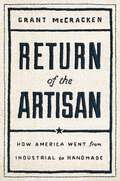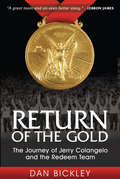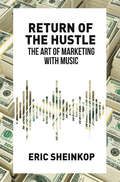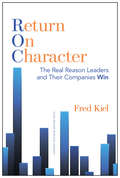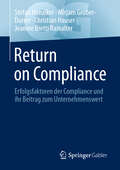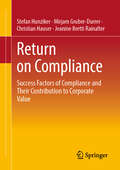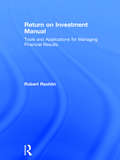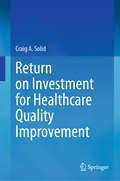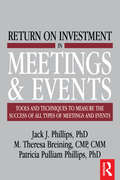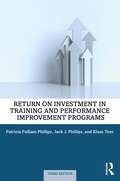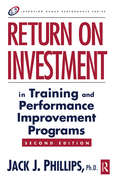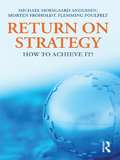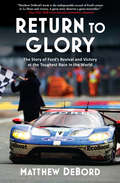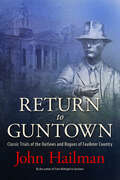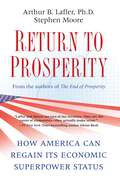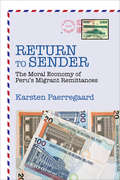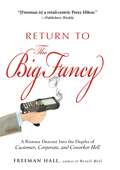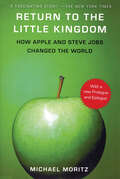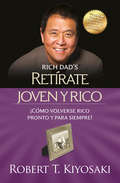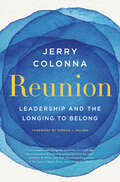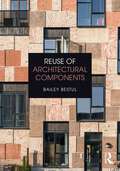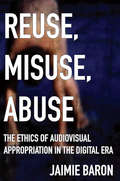- Table View
- List View
Return On Process (ROP): Getting Real Performance Results from Process Improvement
by Michael WestAlthough there are countless books about process improvement and business performance, there is a dearth of literature on how process improvement yields business performance results. Filling this need, Return On Process (ROP): Getting Real Performance Results from Process Improvement provides strategic and tactical guidance on how to achieve a posi
Return of the Artisan: How America Went from Industrial to Handmade
by Grant McCrackenDiscover the evolution of the artisanal movement from the fringes of the 1970s to the spike of domesticity—home-cooking, gardening, and DIY crafting—caused by COVID-19 and what it means for the future of work and American culture.In the 1950s, America was a world of immaculate grocery stores, brightly packaged consumer goods, relentless big brand advertising, homes that were much too clean, and diets so rich in salt, sugar, fat, and preservatives you nearly have a heart attack just thinking of them. And while this approach made a great fortune for large consumer packaged goods companies it has been detrimental to American&’s overall health and wellbeing. Then, towards the end of the 20th century, Alice Waters and other pioneers figured out how to market natural, handmade, small-batch products to the American consumer again—and the rest is history. Now, we are in the third wave of a revolution. Thanks to COVID-19, millions of Americans went from being consumers of artisanal goods to being producers. People in the mainstream are baking bread, keeping bees, growing vegetables, and even raising chickens. Gardens are flourishing, workshops are growing, and sewing machines are whirring. Thousands have left the cities for the countryside, and if their companies don&’t require it, they might never return. Return of the Artisan is a collection of stories and interviews with artisanal businesses across America including family farms and collectives. This book explores their business models, their motivations, and explores how you can join them by turning your own hobby or passion into your work. Whether you want to make this a profession or simply enjoy providing artisanal goods to your family and friends, this book is a must-have for navigating the ups and downs of the latest artisanal revolution.
Return of the Gold: The Journey of Jerry Colangelo and the Redeem Team (Sports Professor)
by Dan BickleySix years after Michael Jordan won his last NBA championship, American basketball hit rock bottom. The perception of NBA players reached an all-time low. Team USA lost three times, disgracing the nation at the 2004 Olympics. With great historical sweep, bringing in the voices of all-time greats like Jordan, Bill Russell, Julius Erving and Jerry West, the book will show how American basketball bottomed out. It will chart the path of Jerry Colangelo, a great sportsman who set out to change the stained image of USA Basketball. And with great insight and fresh detail, it will show how two of the best players in history – Kobe Bryant and LeBron James – spun their own tails of redemption in while winning gold medals.
Return of the Hustle: The Art of Marketing With Music
by Eric SheinkopHas a commercial ever brought you to tears? Has a movie ever inspired you so much you change your way of life? Has the series finale of a television show ever broken your heart? Has a video game ever altered your perception of reality? If you're like most consumers, you answered 'yes' to at least one of those questions. Whether you remember it or not, the music of that ad, film, show or game probably played a big role in influencing your emotional response during that experience. In fact, music is included in media specifically for the purpose of connecting with audiences on a deeper level that visuals alone cannot access. A strong music strategy is fundamental to the success of television, film, brands and video games. Because of higher expectations for audiovisual content, it will take more than clever animation or a celebrity cameo to connect with consumers in an authentic, organic way. By providing audiences with a genuine music experience, whether with an exclusive song through an artist partnership or by featuring new music from an emerging band, you can build a bond that extends far beyond product experience. Music touches us emotionally in a way that words seldom do. We feel it – we remember it.In Return of The Hustle, a leading music and marketing industry insider discusses the diverse audio touchpoints for four key industries and shows how marketers, storytellers, and advertisers can use music to effectively guide audiences along the customer journey from passive consumers to brand advocates. Return of The Hustle provides readers with a blueprint for music strategy that professionals at any level in any industry can use to attract consumers, immerse them into the content, and extend relationships between them and the brand long after the commercial ends or the credits roll. With detailed case studies, exhaustive interviews, and thorough research, Return of the Hustle gives readers the playbook to use the marketing power of music to drive business results.
Return on Character
by Fred KielDoes the character of our leaders matter?You may think this question was answered long ago. Countless business authors and analysts have assured us that great leadership demands great character. Time and again, we've seen that truth play out, as once-thriving organizations falter and fail under the guidance of leaders behaving badly. Why, then, do so many executives remain skeptical about the true value of leadership character? A winning strategy and a sound business model are what really matter, they argue; character is just the icing on the cake.What's been missing from this debate is hard evidence: data that shows not only that leadership character matters for organizational success, but how it matters; and concrete evidence that it leads to better business results. Now, in this groundbreaking book, respected leadership researcher, adviser, and author Fred Kiel offers that evidence-solid data that demonstrates the connection between character, leadership excellence, and organizational results.After seven years of rigorous research based on a landmark study of more than 100 CEOs and over 8,000 of their employees' observations, Kiel's findings show that leaders of strong character achieved up to five times the ROA for their organizations as did leaders of weak character.Return on Character goes on to reveal: How leadership character is formed, how it creates value, and how that value spreads throughout the organization How low-character leaders undermine the success of even the best business plans How leaders at any level can develop the habits of strong character and "unlearn" the habits of poor characterThe book also provides a character-building methodology-step-by-step advice and techniques for assessing your own character habits and improving your performance and that of your organization.Return on Character provides the blueprint for building your own leadership character and creating a character-driven organization that achieves superior business results.you're leading a large organization, a small business, or any group trying to reach an important goal, this book is a guide to help you drive success.
Return on Compliance: Erfolgsfaktoren der Compliance und ihr Beitrag zum Unternehmenswert (Quick Guide)
by Stefan Hunziker Christian Hauser Mirjam Gruber-Durrer Jeanine Bretti Rainalter«Compliance» gilt heute als Grundvoraussetzung für die «license to operate» und ist daher für Organisationen eine kritische Managementfunktion mit einer hoher Ressourcenbindung. Zahlreiche Unternehmensskandale in Zusammenhang mit Compliance-Verstössen lassen vermuten, dass Unternehmen nicht immer in der Lage sind, das unternehmensweite Compliance-risikoadäquat zu managen. Dies liegt u.a. daran, dass es bisher kein etabliertes Verfahren zur Quantifizierung des Erfolgs der Compliance gibt. Daraus folgt ein Legitimationsproblem für die verantwortlichen Führungskräfte, da die (hohen) Compliance-Ausgaben nur schwierig zu rechtfertigen sind. Das vorliegende Buch adressiert diese Herausforderung und zeigt auf, wie der Erfolg und der Wertbeitrag der Compliance in mittelständischen und grossen Unternehmen optimiert werden kann. Dazu wurde ein wissenschaftlich fundiertes Compliance-Modell entwickelt, das den Zusammenhang zwischen erfolgreicher Compliance und dem Unternehmenserfolg nachweisen kann, was einem «Paradigmenwechsel im Umgang mit Compliance» gleichkommt. Compliance darf nicht länger als Kostenfaktor, sondern als nachweisbar mehrwertstiftendes Führungsinstrument verstanden werden.
Return on Compliance: Success Factors of Compliance and Their Contribution to Corporate Value
by Stefan Hunziker Christian Hauser Mirjam Gruber-Durrer Jeanine Bretti Rainalter"Compliance" is now considered a fundamental prerequisite for the "license to operate" and is therefore a critical management function for organizations, requiring significant resource commitment. Numerous corporate scandals related to compliance violations suggest that companies are not always able to manage enterprise-wide compliance risks appropriately. This is partly due to the lack of an established method for quantifying the success of compliance efforts. As a result, a legitimacy problem arises for the responsible executives, as the (high) compliance expenditures are difficult to justify. This book addresses this challenge and demonstrates how the success and value contribution of compliance can be optimized in medium-sized and large companies. To this end, a scientifically grounded compliance model has been developed, which can demonstrate the connection between successful compliance and corporate success, representing a "paradigm shift in the approach to compliance." Compliance must no longer be seen as a cost factor but as a verifiably value-creating leadership tool.
Return on Investment Manual: Tools and Applications for Managing Financial Results
by Robert RachlinThis is a book for presidents of all-size businesses, financial managers, and controllers, on how various decisions can be used to increase an owner's return. Each chapter focuses on specific strategies and their application and relation to risk analysis, and managing key ratios.
Return on Investment for Healthcare Quality Improvement
by Craig A. SolidThis book offers a comprehensive overview of performing return-on-investment (ROI) analyses for healthcare quality improvement (QI). In the United States, healthcare policy regarding physician and facility payment/reimbursement is steadily trending towards the use of “value-based” systems and away from the traditional “fee-for-service” (FFS) payment mechanisms. Healthcare professionals and organizations who have previously focused on quality metrics are now finding themselves burdened with having to define and assess value metrics, without much guidance or assistance. This volume aims to be a guide and a reference for healthcare professionals tasked with estimating and establishing ROI for QI.Chapters describe the general framework for how to perform QI; establish standard definitions of important terms, concepts, and calculations; and provide specific instructions for how to complete each step of an ROI analysis. These include: selecting a QI initiative and identifying the associated metrics, establishing measurable, monetizable, and attributable costs and benefits, determining the appropriate scope and perspective, calculating ROI and related metrics (payback period, benefit-to-cost ratio, etc.), comparing with established benchmarks or previously published results, and interpreting the results for the intended audience. In addition, chapters offer examples of real studies (or hypothetical studies of real situations), as well as templates for several of the necessary activities that readers can leverage for their own use.Return on Investment for Healthcare Quality Improvement is a must-have resource for healthcare providers, administrators, and other professionals who work in healthcare organizations, hospitals and other healthcare settings, health systems, and residency programs seeking to obtain outside funding, as well as policy makers and administrators of federal programs.
Return on Investment in Meetings and Events
by Jack J. Phillips M. Theresa BreiningThe Phillips ROI Methodology™ utilizes five levels of evaluation, which are essential in determining the return on investment.At Level 1 - Reaction and Planned Action, attendee and stakeholder satisfaction from the meeting can be measured. Almost all organizations evaluate at Level 1, usually with a generic, end-of-meeting questionnaire. While this level of evaluation is important as a “stakeholder” satisfaction measure, a favorable reaction does not ensure that attendees have acquired new skills, knowledge, opinions or attitudes from the meeting. At Level 2 - Learning, measurements focus on what participants learned during the meeting using tests, skill practices, role-plays, simulations, group evaluations, and other assessment tools. A learning check is helpful to ensure that attendees have absorbed the meeting material or messages and know how to use or apply it properly. It is also important at this level to determine the quantity and quality of new professional contacts acquired and whether existing professional contacts were strengthened due to the meeting. However, a positive measure at this level is no guarantee that what was learned or whether the professional contacts acquired will be used on the job. At Level 3 - Job Applications, a variety of follow-up methods can be used to determine if attendees applied on the job what they learned or acquired at the meeting. The frequency and use of skills are important measures at Level 3. While Level 3 evaluations are important to gauge the success of the meeting, it still does not guarantee that there will be a positive business impact in the organization or for the attendee. At Level 4 - Business Results, the measurement focuses on the actual business results achieved by meeting participants as they successfully apply the meeting material or messages. Typical Level 4 measures include output, sales, quality, costs, time and customer satisfaction. Although the meeting may produce a measurable business impact, there is still a concern that the meeting may cost too much. At Level 5 - Return on Investment, this ultimate level of measurement compares the monetary benefits from the meeting with the fully-loaded meeting costs as expressed in the ROI formula. All levels of evaluation must be conducted in order to determine the ROI of a meeting or event. The data collected should show a chain of impact occurring through the levels as the skills and knowledge learned (Level 2) are applied on the job (Level 3) to produce business results (Level 4).
Return on Investment in Training and Performance Improvement Programs
by Jack J. Phillips Patricia Pulliam Phillips Klaas ToesThe third edition of this bestselling book guides you through a proven, results-based approach to calculating the return on investment in training and performance improvement programs. The ROI Methodology described in the book has evolved into the most used evaluation system in the world.Patricia Pulliam Phillips, Jack J. Phillips, and Klaas Toes present the ROI Methodology, a user-friendly approach to showing and proving the value of programs, projects, and initiatives. Based on over 40 years of development and refinement, it is a process that meets the demands currently facing training and performance improvement functions. This third edition includes chapters thoroughly detailing the application of the ROI Methodology and new and innovative developments. The book provides examples, case studies and worksheets, and solutions to implementation issues. A case study spans the book and takes the reader through each part of the ROI Methodology. Readers can work through the case, step-by-step, exploring the issues uncovered in the chapter and learn how to apply the process in their own organizations. This book continues to be a primary reference for learning how to utilize ROI to show the contribution of training, education, learning systems, performance improvement, human resources, and change initiatives throughout organizations.Proven to work as a guide for practitioners, managers, and leaders, the book is also ideal for students of learning and development and performance improvement at graduate and postgraduate levels and individuals involved in executive and professional development programs. A complimentary 500-page book with 25 detailed case studies is available to book purchasers. See the offer on page 384 at the back of the book.
Return on Investment in Training and Performance Improvement Programs (Improving Human Performance Ser.)
by Jack J. PhillipsThe second edition of this bestselling book, 'Return on Investment in Training and Performance Improvement Programs,' guides you through a proven, results-based approach to calculating the Return on Investment in training and performance improvement programs.Jack Phillips has composed user-friendly ROI calculations, plus: *ten post-program data collection methods *ten strategies for determining the amount of improvement that is directly linked to training programs *ten techniques for converting both hard and soft data to monetary values 'Return on Investment in Training and Performance Improvement Programs, Second Edition' continues as a primary reference for learning how to utilize ROI to show the contribution of training, education, learning systems, performance improvement, and change initiatives throughout organizations. The book also details implementation issues, provides worksheets, and pinpoints non-monetary program benefits. A case study takes the reader through the ROI process step-by-step.
Return on Strategy: How to Achieve it!
by Michael Moesgaard Morten Froholdt Flemming PoulfeltWhy is it that many companies meticulously following recipes on management and strategy fail? Did Google, Skype, Ryanair, Huawei and a number of other successful companies buy into a well thought out strategy and adhered to that over time? How do companies deliberately opting out of the recipe game and opting into the out-of-the-box-thinking fare? In short, why is it that some companies achieve a higher Return on Strategy than others? Whereas Return on Investment (RoI) has attracted increased attention over the last couple of decades, little, if any, attention is being paid to whether companies do at all achieve Return on Strategy (RoS) and how. This book provides an overview of contemporary strategy literature and recipes brushed up with a view to identifying explanations as to how recipes has seldom worked as intended. One out of several reasons rests on the fact that recipes do not take the so-called X-factor into account. With the X-factor as the starting point the book examines a sample of 50 global companies of which some has achieved a remarkable high Return on Strategy and others failed. The 50 companies covers most continents as some are from the North America, some are from the European continent and others are from different parts of the emerging Asian region – threatening companies from the Western hemisphere. The book explains the reason behind success and failures and provides practical tools as to how companies may increase their Return on Strategy. In the toolbox, you will find a framework on how to increase the Return on Strategy as well a number of dynamic positioning tools, road maps and bearing points. Invariably, more and more companies - including consultants, business leaders and MBAs - now work diligently in order to increase their Return on Strategy and the best of them are here to stay successfully – are you?
Return to Glory: The Story of Ford’s Revival and Victory at the Toughest Race in the World
by Matthew DeBordIn January, 2015 at the Detroit Auto Show, Ford unveiled a new car and the automotive world lost its collective mind. This wasn’t some new Explorer or Focus. Onto the stage rolled a supercar, a carbon-fiber GT powered by a mid-mounted six cylinder Ecoboost engine that churned out over 600 horsepower. It was sexy, jaw dropping, but more than that, it was historic, a callback to the legendary Ford GT40 Mk IIs that stuck it to Ferrari and finished 1-2-3 at Le Mans in 1966. Detroit was back, and Ford was going back to Le Mans. Journalist Matthew DeBord has been covering the auto industry for years, and in Return to Glory, he tells the recent story of Ford. A decade ago, CEO Alan Mulally took over the iconic company, and thanks to a financial gamble and his “One Ford” plan, helped it weather the financial crisis and a stock price that plunged to $1 a share, without a government bailout. It was enough for the company to dream of repeating racing history. DeBord revisits the story of the 1960s, details the creation of the new GT, and follows the team through the racing season, from an inauspicious debut at Daytona where the cars kept breaking down, to glimmers of hope at Sebring, and the team’s first victory at Laguna Seca in Monterey. Finally, DeBord joins the Ford team in Le Mans in June, 2016. This fabled 24-hour endurance race is designed to break cars and drivers, and it was at Le Mans, fifty years after the company’s greatest triumph, that Ford’s comeback was put to the ultimate test.
Return to Guntown: Classic Trials of the Outlaws and Rogues of Faulkner Country
by John HailmanA federal prosecutor in Mississippi for over thirty years, John Hailman routinely worked with federal agents, lawyers, judges, and criminals of every type imaginable. Encouraged by the acclaim for his earlier book, From Midnight to Guntown, he has opened even more of the astonishing cases within the over thirty-five boxes full of trial stories he carried into retirement. Hailman gathers colorful exploits of eccentric modern criminals from William Faulkner's Mississippi, where savvy victims often outwit their criminal perpetrators. Characters range from rich but incompetent drug lords and nationwide gun-runners to bumbling Dixie Mafia kidnappers. The book ends with “Fancy Frauds” in which ingenious con men (and women) offer hilarious but surprisingly sophisticated “special deals” on tax-free gold mines in Mexico and bargain (but bogus) Viagra. Chapters include “Guns, Bombs, and Moonshine Whiskey,” “Drug Kingpins Have Troubles Too,” “Crime Victims Fight Back,” “Mere Theft,” and “Fancy Frauds.” Written to entertain and enlighten, these stories will delight any fan of the true crime genre and anyone who enjoys good writing and the skill of a master storyteller.
Return to Prosperity: How America Can Regain Its Economic Superpower Status
by Stephen Moore Arthur B. Laffer"WE CAN'T TAX AND SPEND OUR WAY BACK TO THE GOOD TIMES." -- Arthur B. Laffer and Stephen Moore When Arthur B. Laffer spearheaded the theory of supply-side economics and became a member of President Reagan's Economic Policy Advisory Board, he took his place as an economic icon. More recently, he joined with Stephen Moore and Peter J. Tanous to write The End of Prosperity -- a clarion call delineating what is wrong with current political approaches to America's present economic challenges. Steve Forbes himself described The End of Prosperity as "brilliantly insightful," saying "READ IT -- AND ACT!" Now Arthur Laffer and Stephen Moore follow the rousing success of The End of Prosperity with a book even more vital to America and Americans, delivering a plan that shows how our country can regain its lost prosperity. With the economy flat on its back, unemployment at a twenty-five-year high, and the housing default crisis still worsening, is this even possible? But America can once again become the land of economic opportunity, and this brilliant new book tells us exactly how. While President George W. Bush and President Barack Obama may hail from different parties, their response to the crisis has been strikingly similar. The Bush-Obama plan is a failure that has produced nothing except a cascade of trillions of dollars of debt. Is the situation hopeless? No, say Arthur Laffer and Stephen Moore resoundingly, the situation is not hopeless. A return to prosperity is still entirely possible...if the correct strategies are followed. In The End of Prosperity, the authors primarily discussed how lower taxes are essential to economic growth. Now, in Return to Prosperity, they detail the other essential components: putting government at all levels on a low-fat diet; emphasizing debt reduction and retirement; and bringing back the investor class in America, where every American can "own a piece of the rock." In a time where most of the proposed solutions are fraught with peril, the argument provides a refreshing counterbalance. The Return to Prosperity is a prescription that gives America the fundamental tools it needs in order to set about recovery. This book is an urgently needed road map to renewed prosperity, and it is vital reading for anyone who worries that the current economy is faltering, with no clear plan articulated for recovery.
Return to Sender: The Moral Economy of Peru's Migrant Remittances
by Karsten PaerregaardThe aim of this book is to examine how Peruvian migrants living in different parts of the world use their savings and experience in Peru as well as to the development of their regions of origin and new countries of settlement.<P> The book's title, Return to Sender, refers to the money that migrants send to their relatives and communities in Peru. But even though the sending of remittances is the book's main them, it also explores another less-documented aspect of migration: the many talents that Peruvian migrants mobilize to achieve their goals. The book is therefore not only a study of why and how migrants remit money home, but also an account of the ways they make their dreams come true and hereby enrich the surrounding society.
Return to the Big Fancy: A Riotous Descent Into the Depths of Customer, Corporate, and Coworker Hell
by Freeman HallBigger, Fancier, and more cutthorat than ever!When Freeman Hall left The Big Fancy to pursue his screenwriting dreams, he thought the horrors of working in a handbag department were finally over. But instead of fame and fortune, he found himself stuck behind a wall of script-killing rewrites, unable to make a living.In Return to the Big Fancy, Freeman shares his wildly entertaining journey back through the fiery gates of Retail Hell. He thought he had seen it all in his day, but with the bar set higher than ever before, employees are now graciously bowing before Corporate as they climb over fellow salespeople, and even friends, to earn enough transactions and commissions to actually survive. As he learns more of the wretchedness that has befallen the sales floor, he realizes that The Big Fancy has its customers and its employees on a short leash. But leave it to Freeman and the threat of disappearing commissions to rally the retail slaves and show Corporate who's really in charge!
Return to the Little Kingdom: How Apple and Steve Jobs Changed the World
by Michael MoritzTwenty five years later, revisiting the first authorized biography of Apple and its co-founder and celebrity CEO, Steve Jobs In 1984, The Little Kingdom: The Private Story of Apple Computer told the story of Apple's first decade alongside the histories of Steve Jobs and Steve Wozniak. Now, completely revised and expanded, Return to the Little Kingdom is the definitive biography of Apple and its founders from the very beginning. Moritz brings readers inside the childhood homes of Jobs and Wozniak and records how they dropped out of college and founded Apple in 1976. He follows the fortunes of the company through the mid-1980s, and in new material, tracks the development of Apple to the present and offers an insider?s profile of Jobs, whose genius made Apple the powerhouse it is today. Required reading for everyone who's ever listened to music on an iPod, Return to the Little Kingdom is timely and thorough, and the only book that explains how Steve Jobs founded the company that changed our world.
Returning to Rushmore: Flying Without a Net--Six Steps to Help You Turn Your Fear of Change into Fuel for Success
by Thomas J. DelongDo I matter? Does my work matter, or am I just expending a lot of energy to keep myself looking important and industrious? If you're a high achiever you may be afraid of the answers to these hard questions, but seeing clearly the ways in which you have sought purpose in your life is the real key to professional success and personal fulfillment. Leadership expert Thomas DeLong begins this chapter with a deeply personal and inspiring story about taking his young daughter to see Mount Rushmore--and the questions that experience raised about his own sense of significance in life. He then offers six catalyzing steps you can follow to sustain you on your journey toward fulfilling your potential. In short, if you can resist the tendency to be controlled by your anxieties, you'll find that life--and work--can be an endless adventure of possibilities. Through self-awareness, and with a support network to help you through the rough spots, you can learn to fly without a net and, ultimately, find greater meaning and satisfaction in every challenge you undertake. This chapter was originally published as Chapter 14 of "Flying Without a Net: Turn Fear of Change into Fuel for Success."
Retírate joven y rico: ¡Cómo volverse rico pronto y para siempre!
by Robert T. KiyosakiEl especialista en temas de finanzas personales, Robert T. Kiyosaki ofrece en este libro una serie de consejos, a través de su experiencia, para retirarse joven y con dinero. De Robert T. Kiyosaki, autor de los bestsellers: Padre Rico, Padre Pobre, el libro #1 de finanzas personales de The New York Times por más de seis años; Niño rico, niño listo, Segunda oportunidad, entre otros . ¡Cómo volverte rico pronto y para siempre! Este libro cuenta cómo Kiyosaki comenzó sin nada y logró retirarse con absoluta libertad financiera en menos de diez años. Encuentra la fórmula para lograrlo. Si entre tus planes no está el de trabajar mucho toda tu vida... este libro es para ti. ¿Por qué no retirarte joven y rico?
Reunion: Leadership and the Longing to Belong
by Jerry ColonnaBuilding on the success of Reboot and the concept of radical self-inquiry, executive coach Jerry Colonna encourages leaders to consider the ways they have been complicit in, and benefitted from, the conditions in the world they say they’d like to change and shows them the path to creating new systems of inclusion for everyone.We all want to belong. For executives and managers, to be better leaders—and people—we must create welcoming environments in which ourselves and others feel recognized and have a place. But to do so, we must first face our own need for belonging and how that need is often thwarted. Colonna argues that only through radical self-inquiry can we come home to ourselves and others and, in doing so, create systemic belonging—homes—for everyone.Many people in power fall into the trap of toxic leadership. But this toxicity can be overcome. Colonna guides us on a journey of reunification with the disowned parts of ourselves, the myths and truths of our ancestors, as well as a deeper connection with those most affected by systems of exclusion. He shows how to apply radical self-inquiry (“How have I been complicit in creating the conditions I say I don't want?”) and broaden it to include “How have I been complicit in maintaining systems of oppression that I say I don’t want?” And, more important, “What do I need to give up that I love in order to have the systems of belonging that I want?”The necessary first step is for leaders and others who hold power to see themselves clearly. The vital second step is to see and alter the effects of one’s untended, unhealed wounds and beliefs on those we are tasked to lead.Doing so, we are then able to reimagine businesses as collectives where a shared sense of belonging thrives. Doing so will cause a reckoning with the accepted definitions of leadership, success, and value.With its unusual blend of poetry, quotes, and examples from Colonna’s own life as well as the lives of his clients—Reunion is a life-altering guide for today’s complex and divisive world. Its wise insights and practical advice will help create an inclusive and welcoming workspace, discover the best of who we are, and nurture and support those whom we are privileged to lead.
Reuse of Architectural Components
by Bailey BestulAs the need for a circular construction industry becomes progressively more apparent, building practitioners are increasingly turning to salvaged building components to construct new projects. Yet the aesthetic potential of reused materials remains underexplored. Drawing from art history, architectural theory and constructed works, this book develops a set of design strategies practitioners might employ to develop thoughtful, architecturally rigorous reuse projects. Author Bailey Bestul illustrates the immense design potential of reuse using nine themes that follow the reader from the initial stages of building planning to the finishing of the interior spaces.Following an overview of the history of component reuse in building design and construction, the first part of this book, “Planning strategies,” provides recommendations for the integration of scavenged building elements into the larger architectural work. From the “gap” to the “wrapper,” these chapters consider how designers might arrange reused components both to shelter and be sheltered, while revealing the age and flaws of these components for maximum design effect. The next part, “Assembly techniques,” considers how reuse projects might be constructed and the way in which the construction method impacts the architectural proposal. Whether framing with sticks or stacking up stones, these chapters demonstrate the variety of assembly opportunities available for found object projects. Finally, the part on “Finishing” suggests the ways these materials can create experiential spaces that may be variously uniform, deeply complex and highly embellished.Expanding upon the practical steps outlined in the technical literature, this book provides designers with a set of frameworks for approaching architectural reuse during the more conceptual parts of the design process. It is essential reading for professionals interested in integrating reuse in their architectural practice.
Reuse, Misuse, Abuse: The Ethics of Audiovisual Appropriation in the Digital Era
by Jaimie BaronIn contemporary culture, existing audiovisual recordings are constantly reused and repurposed for various ends, raising questions regarding the ethics of such appropriations, particularly when the recording depicts actual people and events. Every reuse of a preexisting recording is, on some level, a misuse in that it was not intended or at least anticipated by the original maker, but not all misuses are necessarily unethical. In fact, there are many instances of productive misuse that seem justified. At the same time, there are other instances in which the misuse shades into abuse. Documentary scholars have long engaged with the question of the ethical responsibility of documentary makers in relation to their subjects. But what happens when this responsibility is set at a remove, when the recording already exists for the taking and repurposing? Reuse, Misuse and Abuse surveys a range of contemporary films and videos that appropriate preexisting footage and attempts to theorize their ethical implications.


